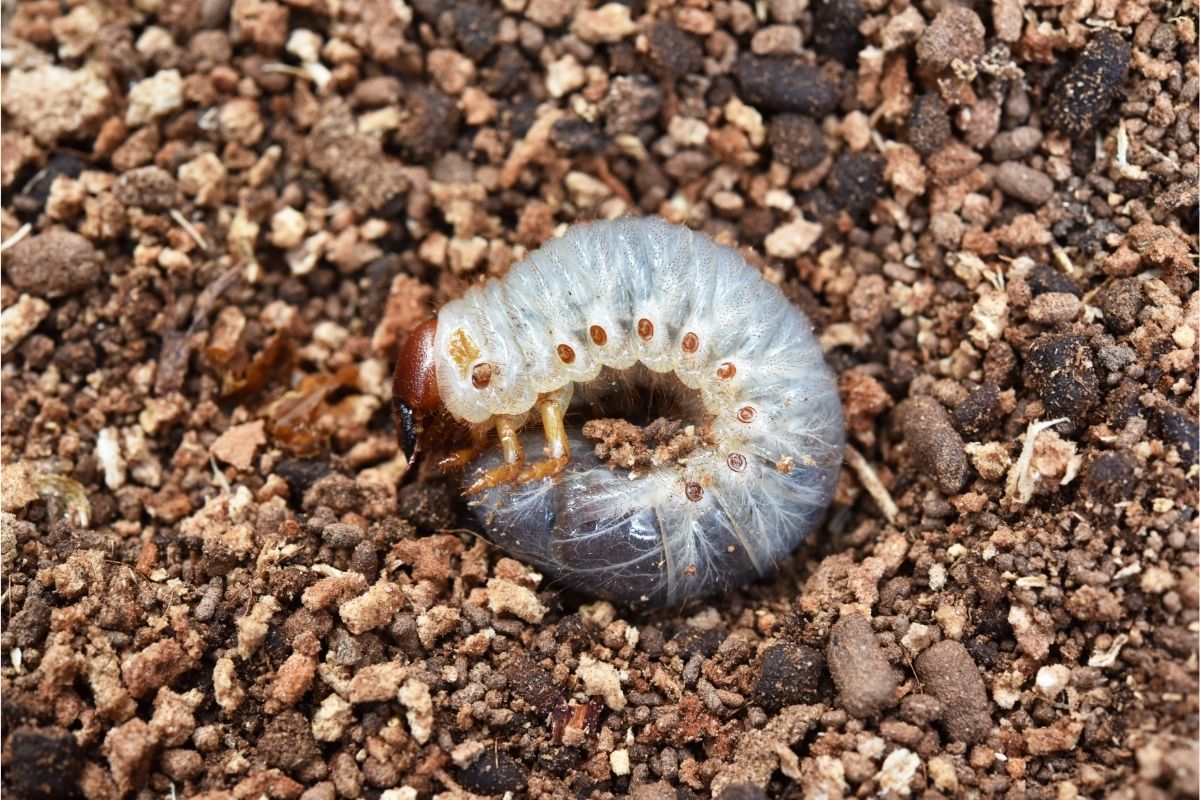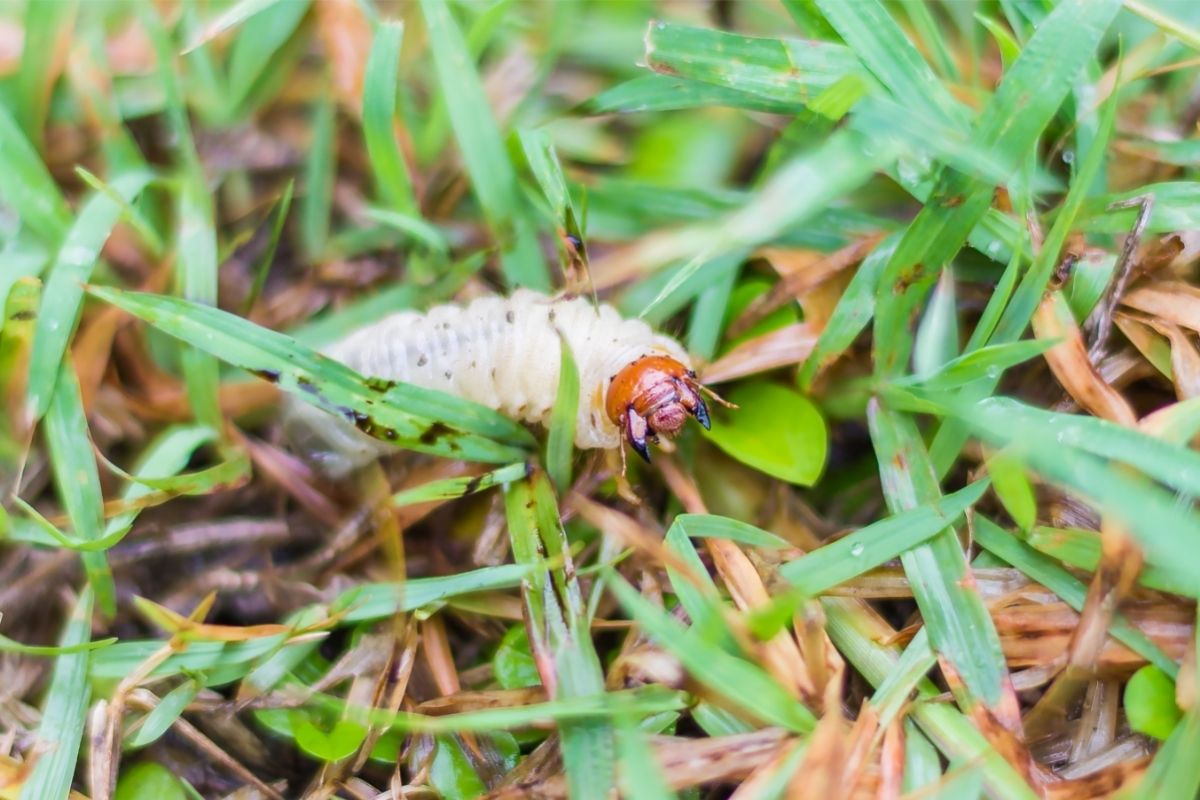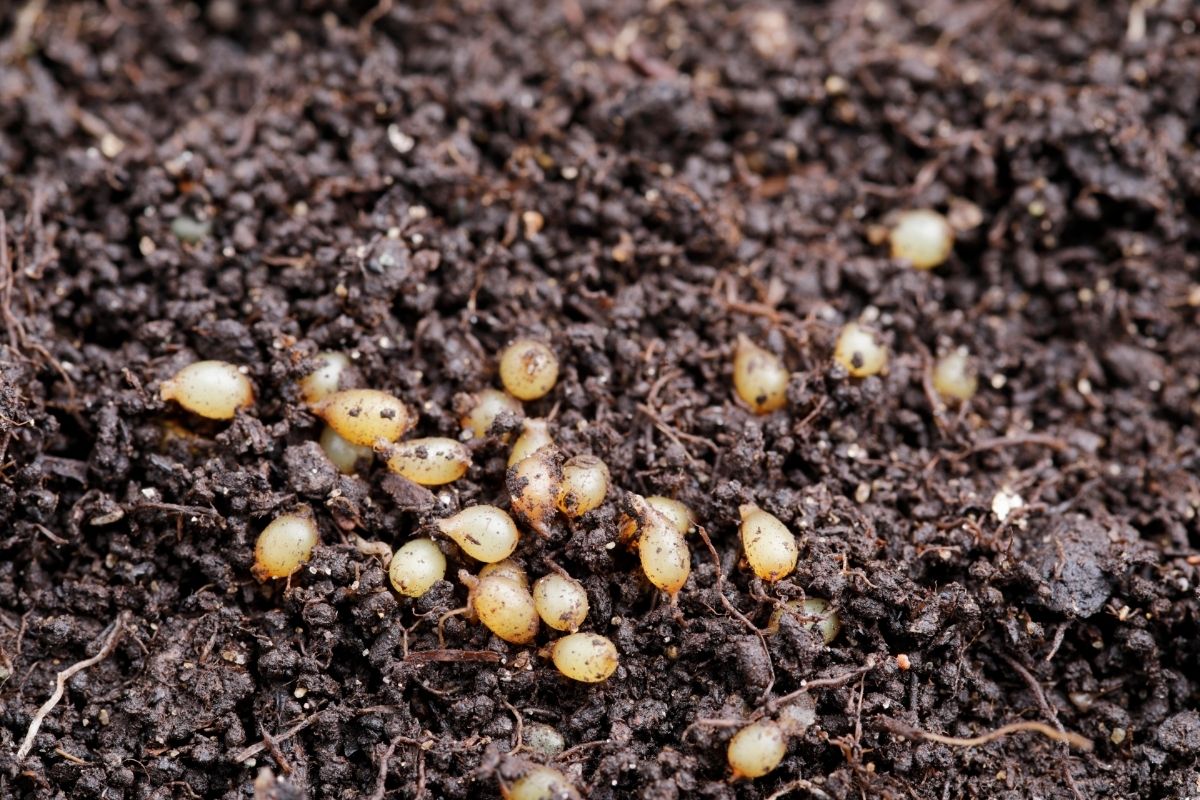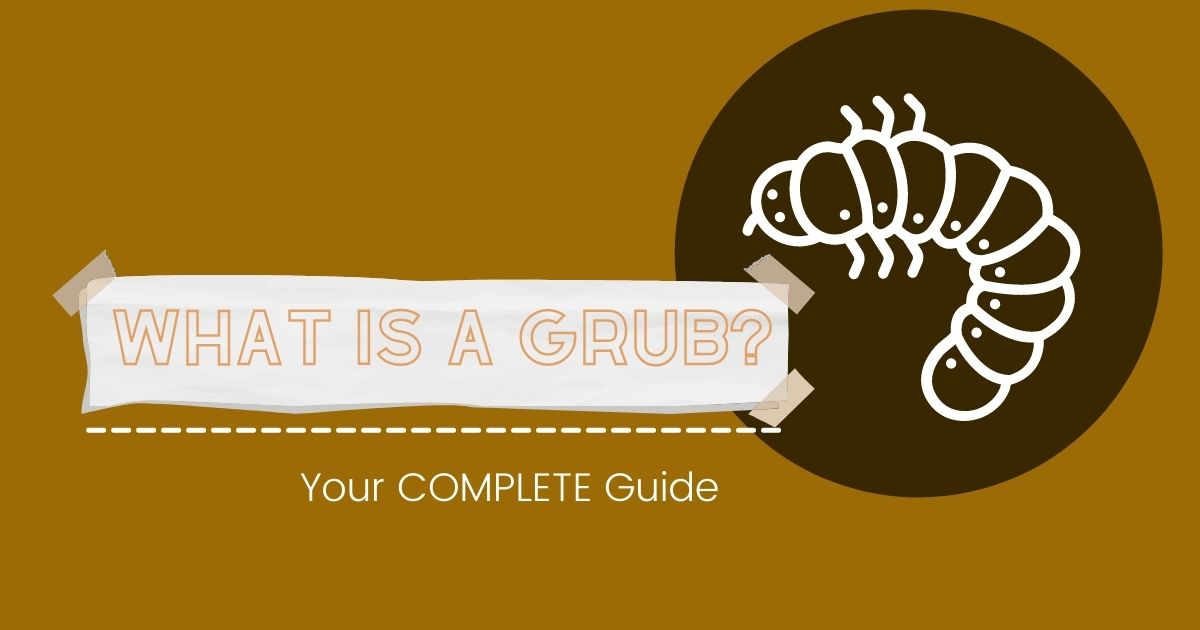You may be wondering, “What is a grub?“ if you have seen little white grubs in your soil. Many lawns in the United States suffer from the white grub worm infestation. Upon learning more about the grub worm and identifying an infestation, you can then begin strategizing ways to get rid of them and prevent future infestations.
What are Grubs?
Grub worms are larvae of beetles from the scarab family. They live beneath the ground and feed on plant roots, fungi, or other invertebrate life, such as caterpillars. Their body color is creamy-white, and have an orange head and six legs at their front.
Lawn grubs are a great issue that homeowners face in their yards. Your yard can suffer significant damage if left untreated. The most common grubs are Japanese beetle, June bug, European Chafer, and Green June beetle. They’re not worms- they’re beetle larvae.

What do Grub Worms Turn Into?
Have you ever wondered, “what do grub worms turn into”? Well, grubs usually become adult beetles in the autumn and lay eggs for the next generation at that time. They spend the winter as a grub, buried in the soil, often under tree roots or decaying logs. In late spring or early summer (January through June), they come to the surface and crawl up the tree’s trunk to feed, and again as they grow.
They mature as beetles in July and August, and the females lay eggs that hatch into grubs that go back into hibernation until the next season.
How to Identify a Grub
To identify lawn grubs, you first need to identify the plant that is being eaten. If you have a rose bush, it is likely to attract rose chafers (Phyllophaga spp.). If your ivy has been stripped of its leaves yet otherwise looks healthy, it may be attracting Japanese beetles (Popillia japonica). Grubs from these two beetles can be differentiated by their mouthparts.
Grubs from the rose chafer have chewing mouthparts, while grubs from Japanese beetles tend to be a half-inch long, have a white body with a brown head, and have eight dark stripes on their back. This is not proof though, due to some exceptions in both beetles’ life cycles, so further steps are needed to identify your grub positively.
Larvae of beetles in the Scarabaeidae family cause more extensive damage than other species and can be identified by their C-shaped, whitish bodies with brown heads. When disturbed, these grubs will also curl into a “C” and may also have some hair on their body.
King grubs (Melanoplus spp.) feed on deer grass and Bermuda grass. They have a brown head and greenish-brown body with longitudinal stripes of dark hair. These larvae may cause more damage than others, as they can grow up to two inches long.
Grubs bug identification may become more difficult in the case of Southern masked chafers (Cyclocephala lurida) and Oriental beetles (Exomala Orientalis). Although these grubs can be identified by their dark brown heads and white bodies with a brown band around the center, they may go unnoticed by homeowners.
Their larvae of grub worms in the garden are often cream-colored with no stripes on their back and may not cause significant damage to the lawn. When you notice Oriental beetle grubs, they have already left your grass, going into the soil to pupate.
Protective cream-colored nets may appear on your lawn when you have a chafer infestation, but this is not always apparent. To determine whether your plants have grub problems, dig around their roots and examine their root systems for tunnels or dead patches of grass.
What do Grub Worms Feed on?
Grubs in grass feed on various things, including decaying organic matter, bacteria, and other small invertebrates. Let’s dive deeper into what they feed on. They are sometimes not always helpful because they eat dirt, which can help people grow crops. Sometimes Grub worms will run wild and have no purpose except to destroy things.
Below are some of the things that grub worms feed on:
Insects That Live on Trees
Grubs can be found under trees where the insects live. This includes other grub worms, termites, and other insects. The grub feeds on other insects.
Bacterial Ooze
It also feeds on bacteria that are in a pool of bacterial ooze. Some grub worms feed on this by crawling into the clump and eating the bacteria from within it.
Burrowed Dirt
Grubs feed on the ground under the rotting tree. It eats through the soil and plant roots to get to more insects.
The Bone Marrow of a Dead Animal Carcass
In some cases, grub worms are known to feed on the bone marrow of animals. It feeds on animals that have died naturally; hence the rotting carcass is a perfect place to live.
Soil Under Crops
Grubs can also be found in the soil under crops. They feed on weeds that grow at the base of the crop. The grub feeds below the soil surface and does not require light to survive.
Grub Worms Feed on Decomposing Vegetation
If you have a compost pile, you need to ensure that the contents are covered with dirt or sand. This will prevent grubs from getting to the compost. Organic matter such as leaves and bark also provides food for grubs.
Grass and Other Vegetation
To prevent grubs from growing, you must take the time to maintain your yard. Having a lot of weeds will provide an ample supply of food for grubs, resulting in a larger population of grubs in your yard.
How do Grub Worms Damage Grass?
Grub worms in the garden cause a lot of damage to the grass. However, it is not the grub worms directly causing damage to the grass, but somewhat indirectly. The most common types of grubs that do most of the destruction are June’s and White Grubs.
The white grubs dig tunnels in your lawn and eat organic material beneath the surface. As they dig, they introduce their saliva to the grass. The saliva is called “cementum.” This cementum hardens immediately after its introduction and lasts for years.
After the cementum hardens, it prevents water from reaching the roots of your grass, which kills it. These former tunnels also prevent sunlight from reaching your grass, which can also cause it to die.
June Beetles are the grub worms that dig into your lawn and lay their eggs. They often live in compost piles, and if a compost pile is close enough to your home, the beatles may enter your grass from there. These grubs hatch and do precisely what White Grubs do when they lay their eggs, but on a much smaller scale.
The tunneling is done with their legs rather than their mouths, which is why the tunnels are not filled with cementum. You will, however, also experience grub damage to the lawn. This is because these tunnels make it harder for your grass to absorb sunlight and water while also making it easier for disease-causing fungi and parasites to enter your yard.
Grub worms cause a lot of damage, but they will not destroy all of your grass. You can often tell how much damage they have done based on their coloration. If the tunnels they make are white, then there is a good chance that a lot of your grass will stay alive. However, if the tunnels are black or brown, then there is a good chance that most of your grass will die due to not receiving adequate amounts of water and sunlight.

What Time of Year do Grubs Damage Lawn?
Grubs bug damage the lawn during Spring. This period is known as the time of year when grubs are active. Grub damage is most common if lawns are not mowed or watered correctly. The grubs come out during the spring and summer.
They cause irregular patches in the lawn, which are brownish-green in color. This damage can make it hard for grass to grow back. The longer you leave it, the harder it can be to get rid of.
Grubs use their sharp jaws to eat grassroots. As they grow bigger, they create tunnels beneath the soil’s surface. The tunneling action can make it difficult for grass to grow back if the damage is left untreated. Leaving grub damage untreated will also attract other infestations.
The grubs attract other insects such as ants, centipedes, and rove beetles. They also attract predators such as blackbirds, crows, and skunks. Grubs that aren’t taken care of can damage the lawn badly enough to make it look like crabgrass or weeds have grown on top of it instead of grass.
Grubs in grass are an annual problem, which means they likely come back every year. They overwinter (remain alive through winter) in the ground as larvae. The larvae grow into pupae during the spring moth flight season.
They hatch into adult beetles and lay eggs in the soil when this period ends. The grub lifecycle typically lasts 7 to 10 months.
The best time to treat lawns for grubs is during the fall. This is when the adult beetles are mating and laying eggs in the soil.
What Does a Grub Worm Infestation Look Like?
Grub worm infestation is a common problem for lawns across the United States. The following are signs that grub worms may be present in your yard:
A significant thinning of the grass in places throughout your entire lawn. Grub worms tend to feed on the roots of the grass and disturb an area as large as a football field, or more can be noticeable very quickly.
Grubs tend to stay in one spot during their early life cycle before becoming flying insects. This means that if you see a lot of dead areas, it is more likely that grub infestation is occurring because that area didn’t spread out from a single location.
If you have pets, they may start going to the bathroom in different spots all over your yard once grub worms are present because there isn’t enough foliage for them to eat anymore. They need to eat grass to survive.
You may also see moles and skunks in your yard more often if grubs are present because they love to eat them.
Grub worms have a white C-shaped body with a brown head and can grow up to 1 inch (2.54 cm) long. If you see any creatures that match this description in your lawn, grubs are likely causing the damage.
A grub infestation may be blamed for bare patches in your lawn after you have applied fertilizer. This is because untreated grubs eat away at the grassroots causing damage to the lawn that makes it appear thin and patchy when they are present in large numbers.
Grub worm infestations generally increase in late summer when adult beetles lay eggs in the soil, which hatch into larvae during the fall months. Larvae feed on plant roots until cold winter temperatures force them underground, where pupae emerge as adults the following spring.
You can also check for adult beetles.
If you see any, you can be sure that a grub worm infestation is present. Adult beetles lay eggs in late summer/early fall, so if you are seeing them now, you can be sure that there will be a grub worm problem later this year.
How to Treat a Lawn Grubs Infestation
Some types of grub cause damage to lawns, and others live in water or feed on organic material. These small white larvae grow into dark brown beetles that fly around in search of food at nighttime during the summer months.
They might be drawn to your lights, or they just might have their agenda for flying around outside at night. In any case, you’ll want to get rid of them if they’re destroying your lawn.
1. Identify Beetle Damage
Inspect your grass, by hand, for signs of beetle infestation before applying chemical treatments if you haven’t yet confirmed a grub infestation. For example, if you pull back a flap in some sod, you should look for grubs and their damage.
The larvae will be a creamy white color and typically curl into a C-shape when disturbed. You can also check for mounds of earth on the surface of your lawn that the grubs have thrown up as they tunnel underground.
2. Apply Nematodesor Insecticide
Apply nematodes or insecticides to the soil around your plants if you have identified damage from beetles. Nematodes are natural parasitic organisms that will attack grubs in their underground cells, while insecticides kill adult beetles on contact and also target the larvae.
If you choose to use an insecticide, apply it when the beetles are most active, which is usually at night.
3. Water and Maintain Your Lawn
Water your lawn regularly to help it recover from the grub damage. You may also need to fertilize it with nitrogen fertilizer to help it bounce back. Finally, be sure to rake up any dead patches of grass and dispose of them properly so that new growth doesn’t start from the existing roots.
4. Prevent Reinfestation
Inspect your lawn for signs of beetle damage or grub larvae before you apply a chemical treatment if you have already had a problem with them once this summer.
After treating, water, and fertilizing your lawn to encourage healthy grass growth and prevent another infestation next year, you can also install a wire mesh barrier around the edge of your lawn to keep the beetles out.
5. Consult a Professional
If you do not know how to treat a beetle infestation or you have a large area of lawn to cover, hire a professional exterminator. They will identify the type of beetle causing the damage and prescribe a targeted insecticide with the appropriate active ingredients.
Professional exterminators will also make recommendations for the maintenance and prevention of future infestations.
How to Get Rid of Grubs in Lawn Naturally
While chemical pesticides may be one solution, there are also many organic methods to get rid of these pests.
One method on how to kill grub is to flood the lawn with water. This will push the grubs to the surface, where they can be easily collected and destroyed. You can then either remove them by hand or rake them up.
Another option is to use a natural predator of grubs, such as a nematode. These can be purchased at a garden center and applied to the soil around your plants.
Another excellent method is to use compost tea. This tea should be made from organic material that has been broken down in water for three weeks. Apply the tea to the lawn weekly, and you should start seeing a decrease in the number of grubs.
One of the most popular methods of how to get rid of grub naturally is to use a Milky Spore powder. This can be purchased at most garden stores and is a naturally occurring bacterium that will kill the grubs. The bacterium will continue to work for several years, making it a significant investment.
If you continue to have a problem with grubs, try using a vinegar solution. You can apply this every week to the affected area, and it should start killing them off within a few weeks. However, make sure you don’t use too much, as vinegar can burn tender grasses.
How to Prevent Grubs in Your Lawn
Grass grub worms can cause severe damage to your lawn and can even kill it. Here are five ways to prevent grubs on your lawn:
Water Your Soil Thoroughly
To keep grass healthy, it is essential to water it deeply and regularly as a method of lawn grub control. This will help drown any grubs that may be present and promote healthy root growth.
Apply Grub Control Products
There are various lawn grub control products available on the market, including organic and chemical options. Be sure to read the product label carefully before using it and follow the instructions.
Aerate Your Lawn
Aerating your lawn helps improve drainage, which can help discourage grubs from inhabiting your yard. You can do this by using a manual or power aerator, or you can rent an aerator machine from your local home improvement store.
Overseed Your Lawn
When grass is damaged or killed, it will die off and grow back. This process typically starts with bare patches of dirt. To avoid this, you can overseed your lawn with new grass seeds every fall.
Mulch Your Lawn
Mulching your lawn helps to conserve moisture and keep the soil cool. It also helps prevent weed growth and can be a great way to recycle old leaves and other yard debris.
By following these tips, you can help keep grubs from causing damage to your lawn.
The Grub Lifecycle
The grub life cycle is quite interesting. They start as eggs, which are very small and white. Once they hatch, the Grubs will eat anything organic that they can find. This includes leaves, fruits, and even other insects.
After a few weeks of eating, the grubs will enter the pupa stage. They can protect themselves from the elements and most predators in this form.
After a few days in the pupa stage, they will emerge as adult Grubs with extremely large appetites. They continue eating until it’s time for them to lay eggs again and start a new cycle of life.
Grub worms are a vital part of the ecosystem, as they help break down organic matter. They are also a food source for different animals. So next time you see one, be sure to appreciate this amazing creature.

When to Treat for Grub Worms
Grub worms can be a nuisance, but they are not always harmful. In fact, they will simply go away on their own in most cases. However, there are occasions when grub worm treatment is necessary. So, when do you need to take action?
When to treat grub worms is a common question for many homeowners. The best time to treat is late summer or early fall.
Treatment in these seasons will help ensure that the grubs are killed before they can grow into adult beetles and lay eggs. Treatment in other seasons may still be effective, but there is a greater risk that the grubs will have already matured into beetles.
Homeowners should also keep in mind that treatment will only kill the currently present grubs. However, this will not prevent grubs from appearing in the future.
For this reason, it is essential to check your lawn for signs of grub worm activity regularly and to address any problems as soon as they are noticed. Grub worms can cause severe damage to a yard and should be treated as soon as possible.
If you notice that your lawn is starting to turn brown and die, it might signify that grub worms are infesting the area. Grub worms feed on grassroots and eventually kill off any lawn they attack.
If you notice this happening to your lawn, it’s time to take action against the grub worm infestation.
The Behavior and Habitat of Grubs
Grubs are a type of insect that is classified under the beetle family. They are typically found in soil, feeding on the roots of plants. There are various types of grubs, but most share similar behaviors and habits.
Lawn grubs can be found in most parts of the United States. They’re commonly found in lawns, gardens, and agricultural fields. Grubs are attracted to moist soil, so they often invade areas that have been recently irrigated or rained on.
There are different types of grubs, but all of them share a few common behaviors. Grubs are active during the day and night, and they can travel long distances in search of food. They also like to burrow deep into the soil, where they can stay safe from predators and bad weather.
Grubs are essential members of the ecosystem. They help break down organic matter, which helps fertilize the soil. They also provide food for different types of animals, including birds, mammals, and insects.
Grubs are most active during the day when they can be seen crawling around on the soil’s surface. They will burrow down into the ground at night to avoid being eaten by predators or to escape unfavorable weather conditions.
These worms feed on various things, but their primary food source is plant roots. They can do significant damage to crops and turfgrass if left unchecked. Grubs also play an important role in the ecosystem by helping to break down organic matter in the soil.
Grubs are harmless to humans and pets, but they can be a nuisance. If you find grubs in your yard, there are several things you can do to get rid of them. They live underground for most of their lives but will sometimes migrate to the surface when they are ready to pupate. After pupating, the grub will become a beetle or other insect.
Lawn grubs can be found in various habitats, including forests, meadows, and wetlands. They are widespread in moist areas with rich soil. Grubs can also be found near decaying matter or in compost piles. They are often drawn to light so that they may be found around windows or doors. Some species of grub live in nests or the cavities of trees. Others live underground.
Grubs are omnivorous and eat a variety of things, including roots, stems, leaves, insects, and other small animals. They are particularly fond of earthworms. Grubs have a voracious appetite and can consume a lot of food in a short period of time. Some grub species are agricultural pests, feeding on the roots of plants or plant seeds, while others feed on decaying plant matter, helping to decompose it.
Grub bugs must shed their exoskeleton to grow larger. This process is called molting and involves shedding their skin by splitting it down the back. Once the skin is shed, they are soft for a time while their exoskeleton dries. Next, they eat their old exoskeleton to recover nutrients lost during the molting process. A grub’s diet will determine its color, ranging from white or yellowish-white to pink or red.
Grubs spend most of their lives underground. This is because they are sensitive to light and must burrow deep enough into the earth to avoid it.
Grubs in yards can live for several years, depending on their species. Some grub species may feed upon the roots of plants in various stages of growth until they are ready to pupate. These hatch into flying insects called imagos that leave behind empty pupal cases. Other species of grub pupate and emerge as adult beetles.
You can try using a pesticide or insecticide or remove the affected soil and replace it with new soil. You can also encourage birds and other predators to visit your yard by putting out bird feeders and nesting boxes.
Grubs Up
Grubs are the larval stage of beetles. They eat your lawn and turn it into a brown, dead mess. The best way to get rid of them is by using grub killers. They kill grubs when ingested and break down their bodies, so they can’t do any more damage to your grass or stop eggs from hatching, so there’s no future generation.
A bit of preventative care goes a long way in fighting these pests. You should aerate your soil every month during winter months- this helps worms find food easier which means less competition with grubs (and fewer holes).
